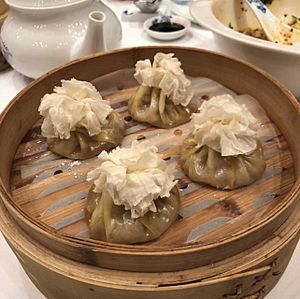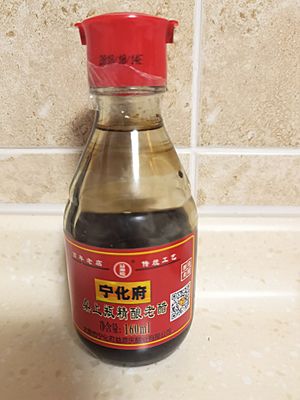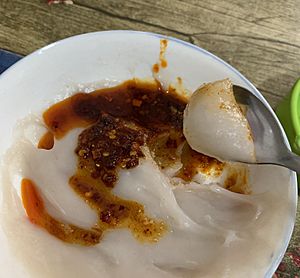Shanxi cuisine facts for kids
Quick facts for kids Shanxi cuisine |
|||||||
|---|---|---|---|---|---|---|---|
| Chinese | 山西菜 | ||||||
|
|||||||
| Jin cuisine | |||||||
| Traditional Chinese | 晉菜 | ||||||
| Simplified Chinese | 晋菜 | ||||||
|
|||||||
Shanxi cuisine, also known as Jin cuisine, comes from the cooking styles of Shanxi Province in China. It's famous for its delicious noodles, fried flatbreads called da bing, and its unique sour flavors. This cuisine is also well-known for using a special local vinegar, much like Huaiyang cuisine, but the taste is quite different.
Shanxi cuisine isn't as widely known outside its region compared to other Chinese foods. This is partly because Shanxi has fewer people than some other provinces. Also, Shanxi is a very traditional place. Many people from outside the area find its food very authentic and old-fashioned.
While pork and chicken are common in Shanxi, lamb is a very popular meat. Parts like goat and sheep offal (internal organs) are also often used. For example, lamb soup often includes livers, stomach, and other offal. Shanxi has strong cultural ties to nomadic groups from Northwest Asia. Because of this, using lamb in Shanxi cooking mixes the food traditions of Northern Chinese minorities and Han Chinese people. For instance, dumplings filled with ground lamb and carrots are unique to Shanxi and not found in other Chinese cooking styles. Another popular dumpling filling is ground pork with chopped dill.
The main foods eaten in Shanxi show what crops grow well there. These include millet, sorghum, and wheat. You'll often find pork, mushrooms, potatoes, and turnips in Shanxi dishes.
Contents
Exploring Shanxi Cuisine Styles
Shanxi cuisine has three main styles, each with its own special touch:
Northern Shanxi Style: Rich and Flavorful
This style includes dishes from Datong and Mount Wutai. Food here often uses more oil and seasonings. It focuses on making dishes look appealing with vibrant colors.
Southern Shanxi Style: Light and Fresh
Dishes from Linfen and the Grand Canal areas show this style. Even though Shanxi is far from the ocean, this style specializes in seafood. The flavors are usually light and fresh.
Central Shanxi Style: A Mix of Tastes
This style is found in Taiyuan, the provincial capital. It's a blend of both northern and southern flavors. Central Shanxi cooking uses carefully chosen ingredients and often has a salty taste. Before the 1970s, Taiyuan food wasn't much influenced by Cantonese or Sichuan styles. It featured many noodle dishes, Chinese Muslim foods, local hot pots, and meat dishes using fresh water seafood and lamb. This area is especially famous for its knife-shaven noodles, called dao xiao mian.
Famous Shanxi Noodles
Shanxi is a paradise for noodle lovers! Here are some of the popular noodle dishes:
- Braised String Bean with Noodles (Menmian)
This dish is popular north of Jinzhong. It's made by stewing noodles and stir-frying them with your favorite vegetables.
- Shanxi Chow Mien (Chao Mian / Chao Jiupian)
For this dish, noodles are pulled into pieces and boiled. Then, they are stir-fried with vegetables. You can add soy sauce, vinegar, sesame oil, salt, and chopped green onions for flavor.
- Shanxi Knife-Cut Noodles (Shanxi Daoxiao Mian)
This is a very famous noodle. Traditionally, a chef holds the dough in one hand and uses a special knife in the other. They shave thin strips of dough directly into boiling water. These noodles are cooked in one piece. You can eat them with many different toppings, like tomato sauce, meat sauce, or lamb soup.
- Shanxi Cats' Ear (Shanxi Mao Erduo)
This fun noodle is shaped like tiny cat ears! You press small pieces of dough forward with your fingers to form the shape. After cooking, you can pour sauce over them or stir-fry them with vegetables.
- Shanxi Kao Lao Lao
This traditional noodle dish is popular in the mountain regions of Shanxi. It's called "laolao" because it looks like a "fence bucket." It's made from oat noodles and usually served with a meat topping.
- Shanxi Oil Cake (Shanxi You Gao)
Also known as fried cake or rice cake, this is a very popular local snack. You'll find it in areas like Jin, Shaanxi, Gansu, and Ningxia.
- Shanxi Shumai (Baihua Shaomei)
The name "Shaomei" comes from how the top of these dumplings looks like a fluffy flower. They are steamed, similar to small dumplings, but they have a more beautiful shape and a unique taste.
- Shanxi Steamed Bread (Shanxi Mantou)
In Shanxi, people call steamed bread "Mo." These "Mo" often have many colorful patterns and designs. Because of their beautiful, flower-like appearance, many people also call them "Huamo," where "Hua" means colorful flowers.
Shanxi Mature Vinegar: A Special Taste
Shanxi mature vinegar, also known as Shanxi lao chencu (simplified Chinese: 山西老陈醋; traditional Chinese: 山西老陳醋; pinyin: Shānxī lǎo chén cù), is a very special type of vinegar made in Shanxi Province. Because of how it's made, it's better described as "aged Shanxi vinegar" or "extra aged vinegar."
This old vinegar is one of China's four most famous vinegars. It has a history of over 3,000 years and is sometimes called "the best vinegar in the world." The longer the vinegar is stored, the more fragrant and tasty it becomes. It also contains many vitamins that can help control blood sugar and blood fat. It's called "Old Chen vinegar" because its basic making process started thousands of years ago and has been passed down and improved over time. Shanxi old vinegar can usually be kept for 9-12 months. Some better vinegars can be stored for at least 3-10 years! Some of the ways this vinegar is made are considered special knowledge and are protected by Chinese laws.
This famous vinegar is mostly made in Qingxu County, which is near Taiyuan, the capital city. There's even a Shanxi Vinegar Culture Museum built there! Local Taiyuan residents, especially those whose families have lived there for generations, prefer Donghu Mature Vinegar (simplified Chinese: 东湖老陈醋; traditional Chinese: 東湖老陳醋; pinyin: donghu). This brand is made by the Shanxi Mature Vinegar Group, which is the biggest maker of mature vinegar in China. Another well-known brand is Ninghuafu Yiyuanqing (simplified Chinese: 宁化府益源庆; traditional Chinese: 寧化府益源庆; pinyin: Nínghuàfǔ Yìyuánqìng), made by the Yiyuanqing Company in old Taiyuan.
In the United States, you can find Shanxi mature vinegar in some Asian grocery stores. Common brands include Shanxi Mature Vinegar Group, a company that has been around since 1368, and Shuita Brand (Chinese: 水塔牌; pinyin: Shuǐtǎ pái), another company located in Qingxu County.
Other Notable Shanxi Dishes
Shanxi cuisine offers many other delicious dishes besides noodles and vinegar. Here are a few examples:
- Cat's Ear (Mao Erduo)
These are noodles shaped like a cat's ears. They are similar to a type of Italian pasta called orecchiette.
- Youmian Kaolaolao
These are rolls made from oat flour. They are shaped like biscuit rolls.
- Fu Shan Mutton Soup (Fu Shan Tounao)
This soup is made from lamb, rice wine, yam, and other spices. Despite its name, it doesn't contain brains! It's named after Fu Shan (傅山; 1607–1684), a famous scholar and artist from Taiyuan. People traditionally enjoy it in winter because it's said to be very healthy.
- Datong Knife-Shaved Noodles (Datong Dao Xiao Mian)
These noodles are shaped like willow leaves. They are made by shaving dough with a sharp piece of metal.
- Liangpi
This is a cold rice noodle dish served with spicy chili oil. It's also called 面皮 (miàn pí). It's made translucent by washing out the gluten before cooking.
- Pingyao Beef (Pingyao Niurou)
This is a special kind of beef produced in Pingyao County.
- Shanxi Crispy Duck (Shanxi Xiang Su Ya)
The duck is first steamed and then pan-fried. This cooking method makes the duck crispy and rich without being too oily.
- Soy Cheese Steamed Pork
Pork is stir-fried first, then steamed in a large bowl. It's cooked with red salty soy cheese curd (similar to what's used in Beijing cuisine), ginger, and garlic. The finished pork is creamy, soft, slightly sweet, and very savory from the soy cheese and pork fat. It's served in thin slices with fresh herbs.
- Sweet and Sour Meatballs (Tang Cu Wanzi)
- Taigu Cake (Taigu Bing)
This is a type of pastry from Taigu County.
- Huamo
This is a type of mantou (steamed bread) that is decorated and shaped in special ways, often like flowers.
- Braised String Bean with Noodles (Menmian)
This dish is popular north of Jinzhong. It's made by stewing noodles and stir-frying them with your favorite vegetables.
- Shanxi Chow Mein
For this dish, noodles are pulled into slices and then stir-fried with vegetables.
- Shanxi Oil Tea
Shanxi oil tea is a traditional snack from Jinzhong, Shanxi. It includes flour, walnuts, peanuts, Xinjiang padamones, cooked sesame seeds, and olive oil.
- Liulin Wantuan
Liulin Wantuan is made from buckwheat noodles. It's steamed in a small bowl and then seasoned with garlic, chili, and vinegar.




